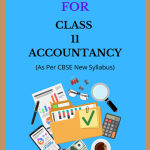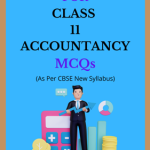NCERT Class 11 Accountancy MCQ Chapter 1 Introduction to Accounting Solutions, AHSEC Class 11 Accountancy Multiple Choice Question Answer to each chapter is provided in the list so that you can easily browse throughout different chapters NCERT Class 11 Accountancy MCQ Chapter 1 Introduction to Accounting Question Answer and select needs one.
NCERT Class 11 Accountancy MCQ Chapter 1 Introduction to Accounting
Also, you can read the AHSEC book online in these sections NCERT Class 11 Accountancy Multiple Choice Solutions by Expert Teachers as per AHSEC (CBSE) Book guidelines. AHSEC Class 11 Accountancy MCQ Solutions. These solutions are part of AHSEC All Subject Solutions. Here we have given HS 1st Year Accountancy Objective Type Question Answer for All Subjects, You can practice these here.
Introduction to Accounting
Chapter: 1
| PART – Ⅰ |
MULTIPLE CHOICE QUESTION ANSWER
1. The art of recording all business transactions in a systematic manner in a set of books is called-
(i) Accounting.
(ii) Book – keeping.
(iii) Ledger.
(iv) None of these.
Ans: (i) Accounting.
2. The process of recording, classifying and summarising all business transactions in order to know the financial result is called –
(i) Book – keeping.
(ii) Accounting.
(iii) Journalizing.
(iv) None of these.
Ans: (ii) Accounting.
3. Which of the following events is NOT recorded in the books of accounts?
(i) Payment of salary.
(ii) Purchase of goods.
(iii) Appointment of a new manager.
(iv) Sale of merchandise.
Ans: (iii) Appointment of a new manager.
4. Cash, goods or assets invested by the proprietor in the business for earning profit is called-
(i) Profit.
(ii) Capital.
(iii) Fixed assets.
(iv) None of these.
Ans: (ii) Capital.
5. A business organisation with a sole owner is known as:
(i) Partnership firm.
(ii) Cooperative society.
(iii) Sole-proprietory concern.
(iv) Municipal corporation.
Ans: (iii) Sole-proprietory concern.
6. Which type of organisation operates with or without a profit motive?
(i) Sole-proprietory concern.
(ii) Partnership firm.
(iii) Not-for-profit motive.
(iv) All of the above.
Ans: (iii) Not-for-profit motive.
7. Cash, goods or assets invested by the proprietor in the business for earning profit is called-
(i) Profit.
(ii) Capital.
(iii) Fixed assets.
(iv) None of these.
Ans: (ii) Capital.
8. Which of the following external users are interested in accounting information to assess the creditworthiness of a business?
(i) Regulatory agencies.
(ii) Creditors.
(iii) Internal management.
(iv) Line supervisors.
Ans: (ii) Creditors.
9. The person, firm or institution who does not pay the price in cash for the goods purchased or the services received is called-
(i) Creditor.
(ii) Proprietor.
(iii) Debtor.
(iv) None of these.
Ans: (iii) Debtor.
10. Who among the following is considered an internal user of accounting information?
(i) Tax authorities.
(ii) Present and potential investors.
(iii) Chief Executive.
(iv) Regulatory agencies.
Ans: (iii) Chief Executive.
11. Which of the following is a key function of accounting information for users?
(i) To generate revenue.
(ii) To serve as the principal source of information for decision-making.
(iii) To manage all departments.
(iv) To help in product pricing.
Ans: (ii) To serve as the principal source of information for decision-making.
12. What is the purpose of the Profit and Loss Account?
(i) To demonstrate the financial situation of a business.
(ii) To summarise revenues and expenses over a specific period.
(iii) To record all transactions of a business.
(iv) To calculate the tax liability of a company.
Ans: (ii) To summarise revenues and expenses over a specific period.
13. What is the purpose of the Balance Sheet?
(i) To show the net income of a business.
(ii) Provide a picture of a company’s financial status.
(iii) To record day-to-day business transactions.
(iv) To calculate the return on investment.
Ans: (ii) Provide a picture of a company’s financial status.
14. Assets easily converted into cash within a short period are known as?
(i) Current assets.
(ii) Fixed assets.
(iii) Intangible assets.
(iv) Investments.
Ans: (i) Current assets.
15. Which of the following financial statements is typically provided to external users?
(i) Cash flow statement.
(ii) Profit and loss account.
(iii) Journal entries.
(iv) General ledger.
Ans: (ii) Profit and loss account.

Hi! my Name is Parimal Roy. I have completed my Bachelor’s degree in Philosophy (B.A.) from Silapathar General College. Currently, I am working as an HR Manager at Dev Library. It is a website that provides study materials for students from Class 3 to 12, including SCERT and NCERT notes. It also offers resources for BA, B.Com, B.Sc, and Computer Science, along with postgraduate notes. Besides study materials, the website has novels, eBooks, health and finance articles, biographies, quotes, and more.





